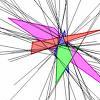RestedGal wrote:
I simply believe the hue and cry I've seen for years on the message boards (not just your posts, Snoredog) about the "danger" of a few random centrals is overdone.
I agree RG, too much is made about the "dangers" of CA. But I also at the same time don't think they need to be ignored. I see CA's showing up as an indicator there is something wrong with the breathing pattern. Stabilize the breathing pattern and they SHOULD go away.
christinequilts wrote:
You've made a lot statements about central apneas over & over again which are incorrect, but any time someone has questioned you or provided alternative information, you've never wanted to hear anything else or even debate the issue.
and with all due respect Christine, I think you are incorrect in lumping all categories of Central apnea seen as CSR or even CSA into one. It is simply not the case.
christinequilts wrote:
If every central results in an arousal, then why did my first PSG show 528 central apneas & only 21 awakenings & 77 arousals? According to you're calculations, I should have had 400 or so more arousals and/or awakenings, right? Thankfully I didn't get the same memo on centrals=arousal or awakenings as you seem have received Wink
That's not to say those centrals didn't disrupt my sleep in other ways, but anyone with that many apneas is going to have pretty poor sleep quality no matter the type.
The point you miss here, is if you were having that many CA's, I'd bet you were never making it to deep sleep or REM? My guess is you probably never got past Stage2 with those number of events.
And as this is related to RG's comment of not getting any deep sleep as we get older, that may be true but if deep sleep and REM were not needed then why do so many end up going to sleep doctors.
Last time I checked there were 3 or more different Central Apnea categories of Central Apnea. What is it they use to classify the different classes? If not mistaken, one form is if you have >10 per hour Centrals and 5 per hour Obstructive, then your primary disorder is CSA Central Sleep Apnea Syndrome.
Then if your breathing pattern is distinct with regular waxing and waning such as seen with Cheyene-Stokes Respiration associated with Congestive Heart Failure (CHF) you have the most severe form CSA.
Then there is what seems to be the newest classification, that is CSA combined with OSA then it is thought you have Complex Sleep Disordered Breathing or CSDB. Now what is it they use there to classify that type? Think they use a combination of "Mixed" apnea to help classify that type. We all know a Mixed apnea is a combination of both.
Then as I learned from SAG recently in Pam's discussion there are Post-Arousal CA's. I already knew there were on-set CA's from a discussion of Wally's reports.
But as I understand it, having a few CA's seen during sleep does not indicate you have CSA, does not indicate you have CSR, does not indicate you are having Post-arousal CA's or if they happen during the beginning of sleep on-set CA's. Then there are pressure induced CA's. In my case, I can make those happen at will if I wanted to.
I also disagree with the theory we are always given that they are neurological. While that may be true if you had damage to your spine and/or brain and the signal doesn't make it there. They say it is the mid-brain or brain stem as the cause. But that should be easy to rule out with today's MRI imaging, I have 9 different sets of high res MRI's sitting in my closet. I've read so many I've found things on them a Radiologist totally missed, but that is beside the point. If you show absolutely no damage to the spine and/or to the brain and you are still having those, I think you can rule out most of the neurological cause debate. Is it the neurological signal that is broken or is it the limit switch? Are the stretch receptors in the lungs neurological?
While CA may be a neurological "function" I don't see it as a dysfunction. One of the chemoreceptors that play a part in respiration is the stretch receptors in the lungs. Does it not sound logical that if those receptors could play a part when pressure induced CA's are seen from artificial pressure?
I said it before and I'll say it again, I don't see Central Apnea (CA) as a problem by themselves. I see CA as indicator something is wrong with respiration. Stabilize respiration and they should go away on their own.
SAG has shown PSG's here with CSR where the AdaptSV does just that stabilizes respiration and the CA's disappear.
When I had my first PSG with NO CPAP, I had 32 CA's per hour. I also had 27hr spontaneous arousals. I had a AHI of 72 per hour. I also had a combination of Mixed apnea. They put me on CPAP most of those went away. Continued use of CPAP I would still be waking up like I wasn't getting enough pressure and still having apnea. I had 3 more PSG's I still had CA's with CPAP. I still woke up dead ass tired. Still do today.
On CPAP my CA's are not severe enough to need a ST machine. I had a complete cardio workup including an angioplasty, no heart disease. They only sent me through that routine during a stroke hunt and that my dad died of sudden heart failure at age of 51.
I have mixed apnea. I have central apnea. Do I think I have CSA? no. Do I think I have CSR? obviously not. Do I think I have CSDB simply because I have a few mixed apnea? Absolutely not. As far as I'm concerned I don't have any of those main categories of CA. Since mine don't take place during sleep onset, I don't feel I have that either. I don't have detailed enough reporting to even rule out post-arousal CA.
But what I do know from my OWN experience, is that nearly all auto's on the market today will confuse CA's for obstructive which can only increase them in frequency. Resmed's conventional auto is terrible with them, its only means of avoidance is the A-10 algorithm, and all that says is it won't trigger or "command on apnea" if the pressure is at or above 10cm to an apnea event, that means it doesn't matter if that apnea is central or obstructive it won't respond to either. It does not matter that the machine may try and avoid them by way of preemptive treatment. That is a bunch of malarkey. If it "confuses" the event, it will store that "confused" event in volatile memory for its pattern matching schema. They went to the A-10 because they didn't have a sensitive enough sensor in the machine to differentiate the two types of events.
Today they do, in fact the sensors are sensitive enough to detect changing CO2 levels. Same for Respironics, I don't think they enabled that NRAH function until they came out with the C-Flex version of the Auto. It was in the reports, but I don't think it worked. Then when you study carefully how that works, you find out it is more an error report than any CA detection schema. Then there is Puritan-Bennett's 420e. It uses a sensor that is much more sensitive and they wrote their software to make use of that sensor by detecting cardiac oscillations. It is pretty accurate when there is an open airway. But not all CA's have an associated open airway so that is where it falls down.
Again, I see CA's as unstable respiration and the human body's way of controlling breathing. If exhausting too much CO2 out of your system leads to more CA's, then doesn't it make sense that if you retained more that it would stabilize. SWS once explained how use of a xpap machine could in theory exhaust or evacuate too much CO2 out of your system. I haven't read too much of that AdaptSV thread, but I've read some and I've read and have the Harvard study. But that thread is simply too long and far in between for me to make out what is being said. The answer could be there that you are aware of, but I can't find it. Besides, I'm a patient not a scientist. I don't care if the machine has MSD ignition or twin turbos, just tell me how it stabilizes my respiration in simple terms by means of manipulation of the respiratory receptors. Use of big long words don't impress me any especially if they totally lose me in the train of thought.
Now for MrPaul, it can be seen on his report. He needs to stabilize his breathing when he does fewer events will be seen on his reports. That is the only gage he has to go by at this point. Once you leave the lab the ability to monitor those CA's goes down the drain unless you have a 420e and Silverling, then you have to know the limitations of that reporting, like it can only differentiate roughly 6 out of 10 seen.
They say CA is rare. I disagree, there seems to be more and more people popping up here with the syndrome. If it were so rare why is it so many people including yourself have it? I have it, you have, I seen RG's 420 reports before she has it. RG doesn't use an AdaptSV and I bet she feels she doesn't need it (but I bet she would like to try it just like me).
And I also disagree when they say they go away after you have been on therapy a while. Well, I've had this more than 6 years and it wasn't until I got the 420e recently I was able to see them diminish with careful setting of the 420e.
The main point is how are they treating it? I suspect from what I have read they are using better machines (i.e. more sensitive at differentiating the types of events seen), applying pressure when needed and avoiding pressure response in the presence of CA. That manipulation combined with careful mask selection (dead space exhaust types, etc.) to control the events seen.
If you have off-the-shelf obstructive apnea, that seems easy to take care of. But how many patients with off-the-shelf obstructive apnea are not like me? Like RG? like yourself? and just don't know it, they were told "don't worry about those they will go away on their own". Tell that to MrPaul, I already know how they can leave you feeling. I have been able to set up my machine to completely avoid them, but my case isn't as severe as the next persons.
I just disagree with lumping everyone category when you see a few CA's as having your condition and that your method applies in all cases.
Sorry, but that is the way I feel about it. RG and I will toss ideas back and forth but we learn as we go. As far as being wrong christine, I'm only close to being right about half the time.
someday science will catch up to what I'm saying...

















